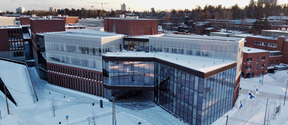DNA builder gets inspiration from nature

Professor Anton Kuzyk, what do you research and why?
As an assistant professor of molecular biophysics, I research DNA as a construction material to build things on a very small scale. This allows us to make structures that wouldn’t otherwise be possible and to make structures with such properties that could be useful for applications in, for instance, biosensing, optics and biomimetics.
Nowadays, there’s a lot of interest in nanoscience and nanotechnology. Often, inspiration comes from nature, as living cells are able to build complex functional nanoscale structures with high precision and accuracy. Scientists want to understand how nature does it, and mimic this in the construction of artificial, man-made systems. This enables us to fabricate nanostructures, materials and whole new systems with novel properties.
How do you build things in nanoscale? One way to do it is with DNA self-assembly, which is based on the fact that carefully designed DNA molecules can weave together, all by themselves, into complex shapes and structures. Our aim is to utilize the power of DNA self-assembly as a construction technique.
How did you end up being a researcher?
More or less by chance. I got involved in research work already during my Bachelor studies in Kyiv. Then, I did my Master’s and Doctoral degrees in Jyväskylä. I got my PhD in 2009, and at that time it was much easier to get an interesting post-doc position than a job in the industry. So, one thing led to another and after several post-doc terms in different places, I ended up on the tenure track at Aalto University.
What have been the highlights of your career?
During my first post-doc period, at the Technical University of Munich, our research team managed to use DNA self-assembly to build a chiral plasmonic nanostructure with novel optical properties, highlighting the power of DNA nanotechnology as a tool for guiding the assembly of nanoparticles into materials with desired electric or magnetic properties. The work was published in Nature in 2012, and since then it has received hundreds of citations. Also, during my second post-doc period, at Max Planck Institute (Stuttgart), we demonstrated the DNA-based assembly of metal nanoparticles into nanostructures with properties that can be manipulated in a controlled way by external stimuli, for example, light, pH or an added chemical.
Now at Aalto University, I’m looking into how to turn these findings into useful functions. As I said, answers might lead to useful applications.
What is the most important quality for a researcher?
Curiosity, of course, is the main driver. As a researcher, I can choose the direction in which I want to go, but as my research is on the borderline of several areas, I benefit from teamwork by getting complimentary expertise from other researchers of various fields and collaborators worldwide.
What do you expect from the future?
My focus points for the next five years will be biosensing and bottom-up nanofabrication. My long-term goal is to create a laboratory where people want to come to work together – to do something that fascinates them, too!
- Published:
- Updated:
Read more news

New origami packaging technology creates sustainable and eye-catching alternatives to conventional packing materials
Origami packaging enables completely new properties for cartonboard, making it an excellent alternative to, for example, plastic and expanded polystyrene in packaging. The aesthetics of the material have also garnered interest from designers.
Quantum physics professor searches for exotic qubit alternatives with new European funding
Aalto University physics professor Jose Lado will use this funding to engineer a new type of topological quantum material that could have applications for quantum bit, or “qubit,” development for noise-resilient topological quantum computation.
Talvikki Hovatta wants to solve a mystery that has plagued astronomers for decades
A new receiver at the Metsähovi Radio Observatory and ERC funding from the European Research Council will enable research into the composition of relativistic jets launched by supermassive black holes